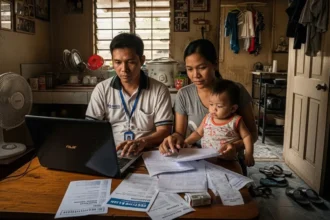Every payday feels like a small celebration – until you check your payslip.
You expected ₱30,000. But the number staring back at you? ₱25,000.
- 📊 Understanding Your Salary Breakdown
- 💸 How Much Tax Is Deducted from Your Salary in the Philippines (2025)
- 🏛️ Understanding SSS, PhilHealth, and Pag-IBIG Deductions (2025)
- 🧮 How to Estimate Your Real Take-Home Pay
- 🧠 Smart Ways to Reduce Taxes and Increase Your Take-Home Pay
- 🏗️ Where Do Our Taxes Really Go? (And Why It Matters)
- 💼 How to Manage Your Money After Taxes and Deductions
- 💬 Frequently Asked Questions
- 🌟 Taking Control of Your Sweldo – One Deduction at a Time
- 🧭 References
And suddenly, you’re asking that classic Pinoy question:
“Saan napunta ’yung ₱5,000 ko?”
For most employees, taxes and deductions are like that mysterious black hole swallowing a chunk of every sweldo. You work hard, you budget tight, but it still feels like something’s missing.
This guide breaks it all down – in plain, human language. No accounting jargon, no complicated BIR talk. Just a real-world explanation of where your money goes, how much is actually deducted, and what you can do to maximize what’s left.
Whether you’re a fresh grad reading your first payslip or a long-time employee still trying to decode those abbreviations (SSS, PH, HDMF, WT), this one’s for you.
📊 Understanding Your Salary Breakdown
Before you stress about how much tax is deducted, you need to understand how your salary is structured – and why your take-home pay never matches your contract amount.
In simple terms, your salary has two faces:
- Gross Income – your total pay before any deductions.
- Net Income (Take-Home Pay) – what’s left after all taxes and contributions.
💼 Common Deductions on Every Filipino Payslip:
- Withholding Tax – based on your income bracket under the TRAIN Law.
- SSS Contribution – your share for retirement, sickness, and maternity benefits.
- PhilHealth – covers medical and hospitalization benefits.
- Pag-IBIG – a small contribution for housing, loans, and savings.
These four are mandatory for employees, and they collectively make your paycheck lighter. Add a few company-specific deductions (like late penalties or cash advances), and that explains why your sweldo sometimes feels bitin before the 15th.
🧾 Sample Comparison: Gross vs Net Salary (2025 Estimates)
| Monthly Gross Salary | Approx. Tax | Mandatory Deductions (SSS + PhilHealth + Pag-IBIG) | Estimated Take-Home Pay |
|---|---|---|---|
| ₱15,000 | ₱0 | ₱1,400 | ₱13,600 |
| ₱30,000 | ₱1,500 | ₱2,100 | ₱26,400 |
| ₱50,000 | ₱4,500 | ₱3,200 | ₱42,300 |
Note: Numbers are estimates based on current 2025 contribution rates and may vary slightly depending on employer share and taxable benefits.
🧩 Local Hack – Know Your Payslip Codes
Those cryptic letters on your payslip actually tell a story:
- WT = Withholding Tax
- SSS EE = Your employee share of SSS
- PHIC = PhilHealth contribution
- HDMF = Pag-IBIG contribution
Once you understand these, it’s easier to track where every peso goes – and spot if something’s off (like missing Pag-IBIG contributions or over-deductions).
💸 How Much Tax Is Deducted from Your Salary in the Philippines (2025)
When you see “Withholding Tax” on your payslip, it’s basically the portion of your income that goes to the government every payday – your share in keeping the system running (roads, schools, hospitals, public workers’ salaries, and yes, even those barangay basketball courts).
But let’s be honest – most of us only care about one thing: “Magkano ang bawas?”
Here’s the real picture.
📘 Understanding Income Tax Under the TRAIN Law
Since 2018, the TRAIN Law (Tax Reform for Acceleration and Inclusion) has simplified how much income tax employees pay. And the good news? From 2023 onwards, lower rates now apply, giving workers slightly higher take-home pay.
Here’s the current 2025 income tax table for compensation earners:
| Annual Taxable Income | Income Tax Due |
|---|---|
| ₱250,000 and below | 0% (Tax-free) |
| Over ₱250,000 to ₱400,000 | 15% of the excess over ₱250,000 |
| Over ₱400,000 to ₱800,000 | ₱22,500 + 20% of the excess over ₱400,000 |
| Over ₱800,000 to ₱2,000,000 | ₱102,500 + 25% of the excess over ₱800,000 |
| Over ₱2,000,000 to ₱8,000,000 | ₱402,500 + 30% of the excess over ₱2,000,000 |
| Over ₱8,000,000 | ₱2,202,500 + 35% of the excess over ₱8,000,000 |
These apply to regular employees whose employers withhold tax every payroll period. So, if you’re employed, your company does the math and sends it to the BIR for you.
💰 Sample Computation: ₱30,000 Monthly Salary
Let’s break it down in plain Taglish so it actually makes sense.
- Gross Annual Income: ₱30,000 × 12 months = ₱360,000
- This falls under the ₱250,000–₱400,000 bracket.
Tax due:
15% of (₱360,000 − ₱250,000) = ₱16,500 per year
Divide that by 12 months = roughly ₱1,375 per month in withholding tax.
So if your payslip shows around ₱1,300–₱1,400 as “WT,” that’s spot on.
🧮 Non-Taxable vs. Taxable Income
Not everything you earn is taxed. Some benefits are considered “non-taxable”, meaning they don’t count toward your income tax computation.
Here’s a quick guide:
| Non-Taxable Benefits (up to limit) | Taxable Beyond Limit |
|---|---|
| 13th Month Pay – up to ₱90,000 | Any amount beyond ₱90,000 |
| De minimis benefits (rice subsidy, meal allowance, uniform, etc.) | If exceeding BIR thresholds |
| SSS, PhilHealth, Pag-IBIG contributions | N/A (always exempt) |
| Night shift differential, holiday pay, overtime pay | Taxable |
| Company bonuses, commissions, incentives | Taxable |
| Allowances (meal, transport) | Taxable unless covered by de minimis list |
Tip: If you’re employed, your HR department should automatically apply these exemptions when computing your withholding tax.
📅 What About 13th-Month Pay?
Every employee looks forward to it – that sweet December cash.
Under the TRAIN Law, your 13th-month pay is tax-free up to ₱90,000 per year.
Anything beyond that gets taxed like your regular salary.
So if you earn ₱30,000/month and get ₱30,000 as your 13th-month, it’s completely non-taxable.
But if you’re a manager earning ₱120,000/month, then part of that bonus crosses the limit and becomes taxable.
💼 Why Minimum Wage Earners Pay Zero Tax
If your basic pay is within the regional minimum wage, congratulations – you’re fully exempt from paying income tax.
That includes most minimum-wage employees in Metro Manila earning around ₱610/day (or ₱15k–₱16k monthly).
However, SSS, PhilHealth, and Pag-IBIG still apply – those aren’t taxes, they’re contributions (we’ll cover that next).
⚖️ Key Takeaways Before Deductions Kick In
- Tax starts above ₱250,000/year. If your annual income is below that, you’re tax-free.
- Employers handle your tax. You don’t need to file unless you’re a freelancer or have multiple income sources.
- Bonuses & commissions are taxable once total pay exceeds ₱250,000.
- 13th-month pay up to ₱90,000 is safe.
- Keep updated with BIR rates – the TRAIN law changes made a huge difference to net pay since 2023.
🏛️ Understanding SSS, PhilHealth, and Pag-IBIG Deductions (2025)
For many of us, these three names show up on every payslip like clockwork: SSS, PhilHealth, and Pag-IBIG.
They’re the “mandatory trio” – small deductions that quietly chip away at your sweldo every month.
But here’s the thing: they’re not taxes. They’re contributions, meaning they go into funds that are meant to benefit you later on – if you actually understand and use them.
Let’s break them down one by one.
🧓 Social Security System (SSS)
SSS is basically your retirement and insurance fund. Think of it as your safety net for old age, sickness, maternity, or accidents.
📘 Contribution Rate for 2025:
- Total rate: 14% of your monthly salary credit (MSC)
- Employer share: 9.5%
- Employee share: 4.5%
- Maximum salary credit: ₱30,000
So if you earn ₱30,000 a month:
→ Your SSS contribution is ₱1,350 (that’s 4.5% of ₱30,000).
→ Your employer adds ₱2,850 on top of that.
| Salary Range | Your Share (4.5%) | Employer Share (9.5%) | Total |
|---|---|---|---|
| ₱15,000 | ₱675 | ₱1,425 | ₱2,100 |
| ₱30,000 | ₱1,350 | ₱2,850 | ₱4,200 |
| ₱50,000 | ₱1,350 | ₱2,850 | ₱4,200 (max cap) |
Local Hack: You can also make voluntary top-ups to your SSS WISP+ (Workers’ Investment and Savings Program Plus) – it’s like a mini-investment that earns more than a regular savings account.
🏥 PhilHealth
PhilHealth is your health insurance – it helps cover hospital bills, operations, and certain treatments.
Whether you’re admitted for pneumonia or need dialysis, PhilHealth kicks in to pay part of the cost.
📘 Contribution Rate for 2025:
- Rate: 5% of monthly salary
- Salary floor: ₱10,000
- Salary ceiling: ₱100,000
- Split: Half paid by employer, half by employee
| Monthly Salary | Total Contribution (5%) | Employee Share (2.5%) | Employer Share (2.5%) |
|---|---|---|---|
| ₱15,000 | ₱750 | ₱375 | ₱375 |
| ₱30,000 | ₱1,500 | ₱750 | ₱750 |
| ₱100,000 | ₱5,000 (max) | ₱2,500 | ₱2,500 |
Local Tip: Always update your Member Data Record (MDR) – especially if you have dependents (spouse, kids, parents). PhilHealth coverage extends to them, but only if they’re listed.
🏠 Pag-IBIG Fund (HDMF)
Pag-IBIG isn’t just about housing. It’s actually a savings program – with perks like affordable housing loans, calamity loans, and even the high-earning MP2 savings program.
📘 Contribution Rate:
- Employee share: 1% (if earning ≤ ₱1,500), 2% (if > ₱1,500)
- Employer share: 2%
- Monthly cap: ₱100 each (for both employee and employer)
| Monthly Salary | Employee Share | Employer Share | Total |
|---|---|---|---|
| ₱10,000 | ₱200 | ₱200 | ₱400 |
| ₱30,000 | ₱100 | ₱100 | ₱200 (max cap) |
| ₱50,000 | ₱100 | ₱100 | ₱200 (max cap) |
Smart Move: Consider the Pag-IBIG MP2 program – it’s voluntary, starts at ₱500/month, and earns around 6–7% annual dividends, tax-free. Great for mid-term savings.
💬 “Ang Dami Namang Bawas!” – But Here’s the Bright Side
Yes, these deductions can make your payslip look heartbreaking, but they’re not dead money.
Here’s what they really do for you:
| Deduction | Main Benefit |
|---|---|
| SSS | Retirement, sickness, maternity, disability, and death benefits |
| PhilHealth | Hospital and medical bill coverage for you + dependents |
| Pag-IBIG | Housing loans, calamity loans, and savings with dividends |
So while you may not “feel” the benefit now, these deductions are basically your built-in safety net – one you’ll be thankful for when emergencies happen.
💡 Budget Move – Check Your Accounts Regularly
You can actually track your contributions online:
- SSS: SSS Member Portal
- PhilHealth: PhilHealth Member Portal
- Pag-IBIG: Virtual Pag-IBIG
Keeping tabs ensures your employer remits properly – especially if you move jobs often or work for smaller companies.
🧮 How to Estimate Your Real Take-Home Pay
If you’ve ever tried to mentally calculate your salary, you’ve probably done the same thing we all do – subtract everything you remember and hope it adds up. But now, let’s do it properly.
Your take-home pay, or net income, is what’s left of your salary after taxes and mandatory deductions.
It’s the real number you can budget with – the one that decides kung may pang-grocery ka pa before sweldo day.
📘 The Basic Formula
Net Pay = Gross Pay − (Withholding Tax + SSS + PhilHealth + Pag-IBIG)
That’s the simple version. In reality, your company might also deduct:
- Late or absent penalties
- Loans or salary advances
- Non-mandatory benefits (like insurance)
But for now, let’s stick to the big four.
💰 Example 1 – Employee Earning ₱30,000 Monthly
Let’s compute your approximate net pay for 2025.
| Item | Computation | Amount (₱) |
|---|---|---|
| Gross Salary | – | 30,000 |
| Withholding Tax | ~₱1,375/month | 1,375 |
| SSS (4.5%) | 30,000 × 0.045 | 1,350 |
| PhilHealth (2.5%) | 30,000 × 0.025 | 750 |
| Pag-IBIG (2%) | Capped at ₱100 | 100 |
| Total Deductions | – | 3,575 |
| Estimated Take-Home Pay | 30,000 − 3,575 | ₱26,425 |
So if you earn ₱30K on paper, your actual sweldo will land somewhere around ₱26,000+, depending on company rounding or benefits.
💰 Example 2 – Employee Earning ₱50,000 Monthly
| Item | Computation | Amount (₱) |
|---|---|---|
| Gross Salary | – | 50,000 |
| Withholding Tax | ~₱4,500/month | 4,500 |
| SSS (4.5%) | Capped at ₱1,350 | 1,350 |
| PhilHealth (2.5%) | 50,000 × 0.025 | 1,250 |
| Pag-IBIG (max) | ₱100 | 100 |
| Total Deductions | – | 7,200 |
| Estimated Take-Home Pay | 50,000 − 7,200 | ₱42,800 |
A common misconception: many people think higher salaries mean massive tax cuts.
In reality, once you cross ₱250K/year, your tax rate rises gradually, not explosively – so higher earners still take home a good share.
📊 Quick-Reference Table – 2025 Take-Home Pay Estimates
| Gross Monthly Pay | Estimated Tax | SSS + PhilHealth + Pag-IBIG | Take-Home Pay (Approx.) |
|---|---|---|---|
| ₱15,000 | ₱0 | ₱1,400 | ₱13,600 |
| ₱20,000 | ₱300 | ₱1,700 | ₱18,000 |
| ₱30,000 | ₱1,375 | ₱2,200 | ₱26,400 |
| ₱40,000 | ₱3,000 | ₱2,700 | ₱34,300 |
| ₱50,000 | ₱4,500 | ₱2,700 | ₱42,800 |
Figures are ballpark estimates. Actual results may vary slightly per company or depending on benefits like non-taxable allowances.
🧠 Budget Move – Use Online Calculators
You can check your own numbers anytime using:
It’s a good habit to cross-check what your employer deducts – especially if your payslip seems off or you recently got a raise.
💬 Local Insight
A lot of Pinoys only realize the real weight of deductions after getting their first paycheck.
If you’re just starting out, don’t be disheartened. Taxes and contributions might shrink your sweldo today – but they’re also building blocks for your future benefits and financial security.
🧠 Smart Ways to Reduce Taxes and Increase Your Take-Home Pay
Let’s be real – no one likes seeing a chunk of their hard-earned sweldo disappear into taxes and deductions. But instead of ranting about it (we’ve all done that over coffee, promise), let’s look at the practical, legal ways to make your income stretch further.
These aren’t shady “tax avoidance” tricks. They’re smart optimization moves that every ordinary employee or freelancer can apply – right now.
💡 1. Maximize Your Non-Taxable Allowances
If your company offers transportation, meal, or clothing allowances, check if they’re within BIR’s de minimis (non-taxable) limits. These are small benefits that don’t count toward your taxable income.
Examples of De Minimis Benefits (2025 limits):
| Benefit Type | Non-Taxable Limit (per month) |
|---|---|
| Rice subsidy | ₱2,000 |
| Uniform/clothing allowance | ₱6,000 per year |
| Medical allowance | ₱1,500 |
| Laundry allowance | ₱300 |
| Meal allowance | ₱2,000 |
| Gift during holidays | ₱5,000 per year |
If your employer structures your salary so part of it is under these benefits, you pay less tax without earning less.
Budget Move: Ask HR if you can adjust part of your basic pay into non-taxable allowances. This simple change can boost your net income by ₱1,000–₱2,000 a month.
💸 2. Take Advantage of Pag-IBIG MP2
Pag-IBIG MP2 isn’t just for homeowners – it’s a savings and investment program that earns around 6–7% annual dividends, completely tax-free.
You can start for as low as ₱500 per month and grow it over five years.
Unlike traditional bank savings, MP2 earnings aren’t taxed, so you keep 100% of your profit.
Example: ₱1,000 monthly for 5 years → roughly ₱70,000+ returns, no tax, no fuss.
That’s like a bonus you built yourself.
🏦 3. Open a Separate “Tax-Proof” Savings Account
Whether you’re employed or freelancing, make it a habit to separate your income streams:
- One account for expenses
- One for savings/investments
- One for taxes and deductions (for freelancers)
Having a “tax-safe” fund helps you avoid spending what isn’t really yours – and gives you better control over what’s left.
Some banks even offer high-yield savings accounts or auto-save features that earn you interest on untouched funds.
📈 4. Consider Fringe Benefits and Employer-Backed Perks
If you’re negotiating a salary or a raise, remember this:
“Not all increases are created equal.”
A ₱3,000 allowance increase could actually give you more take-home pay than a ₱3,000 salary increase – because allowances (if de minimis) are often non-taxable.
Ask if your company offers:
- Internet or phone reimbursements
- Health card (HMO) coverage
- Company shuttle or transport allowance
- Clothing or meal subsidies
These perks can improve your lifestyle without raising your taxable income.
📚 5. For Freelancers and Side Hustlers – Track Your Expenses!
If you’re self-employed or have side gigs, you’re allowed to deduct certain business expenses before taxes.
Some deductible examples:
- Internet bills
- Office supplies or laptop costs
- Software subscriptions
- Utilities (partial, if working from home)
Keep receipts (official, not just screenshots!) so you can declare them properly when filing your annual ITR.
This lowers your taxable income, meaning you pay less in the long run.
Local Tip: The BIR allows you to choose between “8% gross income tax” or “graduated income tax + deductions” – whichever gives you the lower payable amount.
💬 6. Contribute Voluntarily to Government Programs
Even if you’re an employee, you can voluntarily add more to programs like:
- SSS WISP+ – voluntary investment that compounds interest yearly
- Pag-IBIG MP2 – high-return savings
- PhilHealth Optional Premiums – for added coverage
These give long-term benefits that double as future-ready savings, instead of just letting your money sit in low-interest bank accounts.
💼 7. Don’t Forget to File for a Tax Refund (If Applicable)
If your employer over-withheld tax, you might actually be entitled to a refund.
This happens when:
- You switched jobs mid-year
- Your tax bracket changed due to a raise or adjustment
- You had non-taxable benefits not reflected in payroll
You’ll usually see this reflected in your BIR Form 2316 around January or February.
Ask your HR about it – every peso counts, diba?
✨ Key Takeaway
You can’t dodge taxes (and shouldn’t), but you can plan your income smarter.
By understanding how payroll deductions work – and structuring your salary and benefits properly – you could easily save ₱10,000–₱20,000 per year, without earning a single extra peso.
🏗️ Where Do Our Taxes Really Go? (And Why It Matters)
Every time a portion of your sweldo goes to the government, it doesn’t just vanish into thin air – though sometimes it feels that way, di ba? 😅
Your taxes and contributions are the backbone of public services, the quiet fuel behind the systems that (ideally) make everyday life in the Philippines smoother.
Let’s break it down – without the political jargon – so you can finally see where that 10–15% chunk of your paycheck actually goes.
💰 The National Budget Breakdown (2025 Overview)
Each year, the government releases a National Budget, which determines how your tax money is distributed across sectors.
For 2025, the proposed national budget is around ₱6.4 trillion, according to the Department of Budget and Management (DBM).
Here’s how it’s roughly allocated:
| Sector / Department | Purpose | Approx. Share of 2025 Budget |
|---|---|---|
| Education (DepEd, CHED, TESDA) | Schools, teachers’ salaries, free college programs | ~15% |
| Public Works & Infrastructure (DPWH) | Roads, bridges, flood control, airports | ~13% |
| Health (DOH, PhilHealth, hospitals) | Universal health care, vaccines, hospital funding | ~6% |
| Defense & Peace | Military, police, disaster response | ~5% |
| Social Welfare (DSWD) | 4Ps cash aid, food programs, senior citizen support | ~5% |
| Debt Servicing | Payment for loans and interests | ~11% |
| Local Government Support, Others | Internal revenue allotment, LGU budgets | ~10% |
🧾 In short: Every time taxes are withheld from your salary, a part of that money funds your kid’s public school, your neighbor’s hospital treatment, or that new bridge along your daily commute.
🩺 How Your Contributions Fit Into This
Remember the “mandatory trio” – SSS, PhilHealth, and Pag-IBIG?
They don’t go into the general budget. Instead, they go to independent government funds that directly serve their members (you!).
| Contribution | Used For | Who Benefits |
|---|---|---|
| SSS | Retirement pensions, maternity/sickness benefits | Private sector workers |
| PhilHealth | Hospitalization coverage | All paying members + dependents |
| Pag-IBIG | Housing loans, calamity loans, savings dividends | Members and beneficiaries |
So even if you never file for a calamity loan or claim benefits today, those funds build your future financial safety net.
They’re part of your personal economy – not just the national one.
🚧 The Reality Check
Yes, corruption and inefficiency exist – that’s no secret.
But at the same time, a lot of good actually happens behind the scenes that rarely makes the news:
- Public schools running free tuition programs
- Barangay health centers offering free vaccines
- Road projects connecting rural towns to cities
- Subsidized housing through Pag-IBIG
Knowing this helps you see taxes not as punishment, but as shared investment.
It also builds financial awareness: when you know where your money goes, you think harder about how to make the rest of it work for you.
💡 Budget Move – Be a “Tax-Literate” Citizen
Being financially literate isn’t just about savings and investments. It’s also about understanding the system you’re part of.
You don’t need to memorize the DBM budget, but at least:
- Know your rights as a taxpayer
- Track your SSS, PhilHealth, and Pag-IBIG accounts
- Be aware of where government funds are spent
Because being informed is power – and in the Philippines, it’s also protection.
💼 How to Manage Your Money After Taxes and Deductions
Let’s be honest – once your payslip’s been trimmed by tax, SSS, PhilHealth, and Pag-IBIG, it can feel like there’s not much left to work with.
But here’s the truth: even on a modest take-home pay, you can build real financial control if you plan smart.
You can’t control the deductions, but you can control what happens to the rest. Here’s how.
🧾 Step 1 – Know Your “True Salary”
Your true salary isn’t your gross pay – it’s your take-home pay after all mandatory deductions.
This is the only number that matters when you budget, because it’s what actually lands in your ATM.
Example:
If your gross is ₱30,000 but you take home ₱26,400 – your real salary is ₱26,400.
That’s the figure you should base your budget on, not the full 30k you wish you had. 😅
💡 Step 2 – Follow a Simple Budget Formula
You’ve probably heard of the 50/30/20 rule – it’s popular because it works, even for everyday Pinoys.
| Category | % of Take-Home Pay | Examples |
|---|---|---|
| Needs (50%) | Rent, food, bills, transport | groceries, utilities, tuition |
| Wants (30%) | Leisure, shopping, coffee runs | Netflix, dine-outs, hobbies |
| Savings (20%) | Emergency fund, MP2, investments | savings account, insurance |
Local Tip: If your income is tight, start with 10% savings and slowly work your way up. The habit matters more than the number.
🏦 Step 3 – Pay Yourself First
Don’t wait for “leftovers” to save.
The moment sweldo comes in, set aside a fixed amount for savings – even ₱500–₱1,000 counts.
Think of it as your future tax refund from yourself.
Automate it if possible:
- Use a separate savings account
- Or schedule a transfer every payday
When you treat savings like a bill you must pay, it becomes non-negotiable – just like taxes.
🧠 Step 4 – Track Every Peso (Yes, Every One)
You can’t improve what you don’t measure.
Use free apps like Money Manager, Spendee, or even a simple Google Sheet to log your expenses.
You’ll quickly see patterns:
- “Why is ₱2,500 going to milk tea and delivery every month?”
- “Do I really need three streaming subscriptions?”
Small leaks in your budget can quietly drain your savings faster than the tax office ever could.
🧺 Step 5 – Build an Emergency Fund
Life loves surprise expenses – hospital bills, layoffs, sudden repairs.
Set a goal of saving 3–6 months’ worth of living expenses in a separate account (not GCash).
Start slow:
- ₱5,000 → ₱10,000 → ₱30,000
- Eventually enough to cover rent, food, and bills if you lose your job or get sick
It’s your personal version of SSS or PhilHealth – self-funded and instantly accessible.
📈 Step 6 – Grow What’s Left Through Smart Saving Options
Once you’ve built a small safety net, make your money work.
Here are low-risk, Pinoy-friendly ways to grow your savings:
| Option | Where to Start | Expected Return |
|---|---|---|
| Pag-IBIG MP2 | ₱500/month | ~6–7% yearly (tax-free) |
| SSS WISP+ | Optional top-up | ~5–6% yearly |
| Digital banks (Maya, SeaBank, Tonik) | ₱1,000+ | 5–6% interest p.a. |
| Cooperative savings | Local co-ops | 3–5% yearly |
| Mutual funds / UITFs | Banks or COL Financial | 4–8% yearly (varies) |
These aren’t get-rich-quick schemes. They’re slow and steady builders – perfect for busy employees who want their money to quietly grow in the background.
🧭 Step 7 – Review, Adjust, and Celebrate Progress
Revisit your budget every few months.
If your expenses rise, trim something else.
If you get a raise, upgrade your savings first before your lifestyle.
And when you hit milestones – your first ₱10,000 saved, your first MP2 deposit, or finally paying off a loan – celebrate it.
Because that’s proof you’re not just surviving taxes… you’re winning despite them.
✨ Key Mindset Shift
Most people think “tax time” means losing money.
But for someone who plans well, it’s simply part of a bigger system – one where you pay what’s due, claim what’s fair, and manage what’s left with purpose.
You can’t control how the government spends your money.
But you can definitely control how you spend, save, and grow yours.
💬 Frequently Asked Questions
- How do I know if my company is paying my taxes?
You’ll see it in your BIR Form 2316, which lists your total income and withheld tax for the year. If you’re unsure, you can ask HR or check with the BIR Regional Office.
- Is 13th-month pay taxable?
It’s tax-free up to ₱90,000 per year. Any amount above that limit is taxed like your regular salary.
- Do minimum wage earners pay income tax?
No. If you earn the regional minimum wage, you’re fully exempt from income tax, though you’ll still have deductions for SSS, PhilHealth, and Pag-IBIG.
- What’s the difference between gross pay and net pay?
Gross pay is your salary before deductions, while net pay is what actually reaches your ATM. Always budget using your net pay – that’s your real spending power.
- Can I get a refund if my company deducted too much tax?
Yes. Overpaid taxes are usually refunded or adjusted by your employer at year-end, reflected in your December payroll or annual tax report.
- Are freelancers and online workers taxed too?
Yes, but they handle it themselves. Freelancers register with the BIR, choose between the 8% flat tax or graduated rates, and remit their own SSS, PhilHealth, and Pag-IBIG contributions.
- How much is the usual tax on a ₱30,000 salary?
Around ₱1,300–₱1,400 per month under current TRAIN Law brackets. Your exact amount depends on your total annual income and benefits.
- How can I increase my take-home pay legally?
Opt for non-taxable allowances (meal, clothing, transport), and grow savings through Pag-IBIG MP2 or SSS WISP+, which are tax-free. Managing benefits smartly can raise your real net income.
- Why are my deductions different from my co-worker’s?
It depends on your salary bracket, benefits, dependents, or company-specific loans. Even similar salaries can lead to slightly different deductions.
- Where can I check my government contributions?
Use these official portals:- SSS: member.sss.gov.ph
- PhilHealth: memberinquiry.philhealth.gov.ph
- Pag-IBIG: virtualpagibig.gov.ph
🌟 Taking Control of Your Sweldo – One Deduction at a Time
Every payslip tells a story – of hours worked, dreams funded, and yes, a few painful bawas along the way. But once you truly understand where every peso goes, that story starts to shift. You’re no longer just a taxpayer or employee – you’re someone in control of your own financial flow.
You can’t escape taxes, but you can master how they affect your life.
You can’t stop deductions, but you can build savings and investments that work quietly in the background.
You can’t change the system overnight, but you can change how you play within it.
Start small: track your pay, check your contributions, adjust your budget, open that first MP2 account, automate your savings.
Do that for a few months and you’ll notice – your money doesn’t slip away anymore; it starts to stay, to grow, to work.
Because understanding your sweldo isn’t just about math.
It’s about self-awareness, financial maturity, and freedom – one payslip at a time.
🧭 References
-
NTRC – Income Tax Calculator
-
Senate of the Philippines – TRAIN Law 2025 Tax Schedule
-
Taxumo – 2025 BIR Tax Table & Contributions
-
Manila Recruitment – PH Salary Deductions Guide
-
Payday PH – Understanding Salary Deductions










